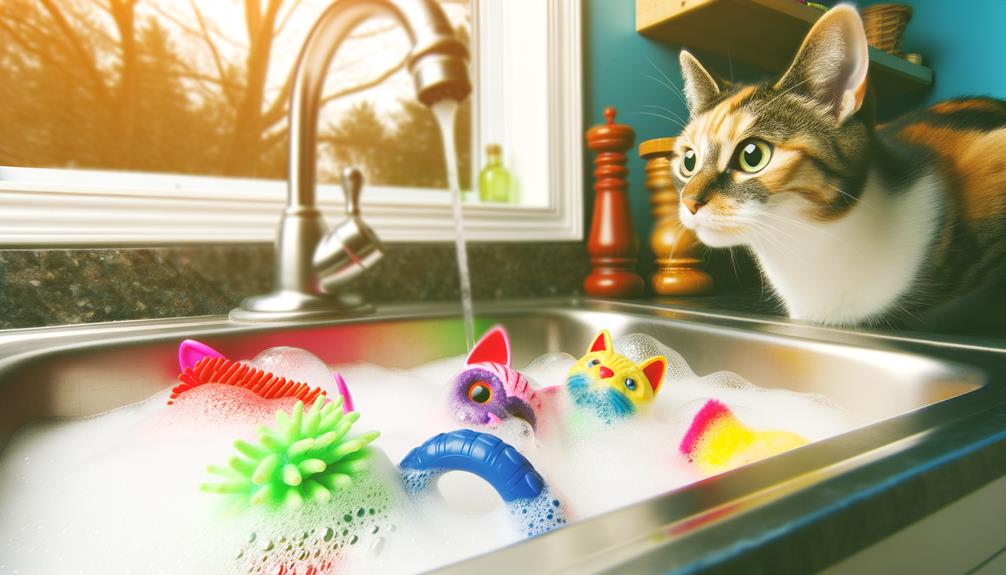You've probably noticed how quickly your cat's toys can get dirty, but do you know the best ways to clean them? It's not just about tossing them in the washer or giving them a quick rinse. Different materials require different approaches, and there are methods that can help guarantee your cat's toys remain safe and long-lasting. Understanding the importance of regular cleaning and knowing the right techniques can make a significant difference. So, what are the most effective ways to keep those toys in top shape without compromising your cat's health? Let's explore the specifics.
Importance of Cleaning
Cleaning cat toys regularly is paramount to prevent the buildup of harmful bacteria, as studies indicate they're among the most contaminated household items, harboring pathogens like Salmonella and E. coli. As a pet owner, you should be aware that cats frequently carry toys in their mouths, which escalates the risk of introducing these pathogens into their system. This behavior underscores the critical need for diligent hygiene practices to safeguard animal health.
When you neglect cleaning cat toys, you're inadvertently allowing harmful microorganisms to proliferate. These pathogens can cause gastrointestinal disturbances, respiratory issues, and even systemic infections in cats. Furthermore, a contaminated toy can act as a vector, transferring bacteria and viruses to other household surfaces and family members, thereby posing a broader public health concern.
In addition to safeguarding health, cleaning cat toys contributes to their longevity. By removing dirt, saliva, and other contaminants, you can prevent material degradation, which reduces environmental waste and the frequency of replacements. This not only benefits your pet but also your wallet and the planet.
A sanitized play environment is also pivotal for minimizing allergies and infections. Dust mites, pollen, and other allergens can accumulate on toys, exacerbating conditions like asthma or dermatitis in sensitive cats. Regular cleaning mitigates these risks, promoting overall well-being.
Cleaning Frequency
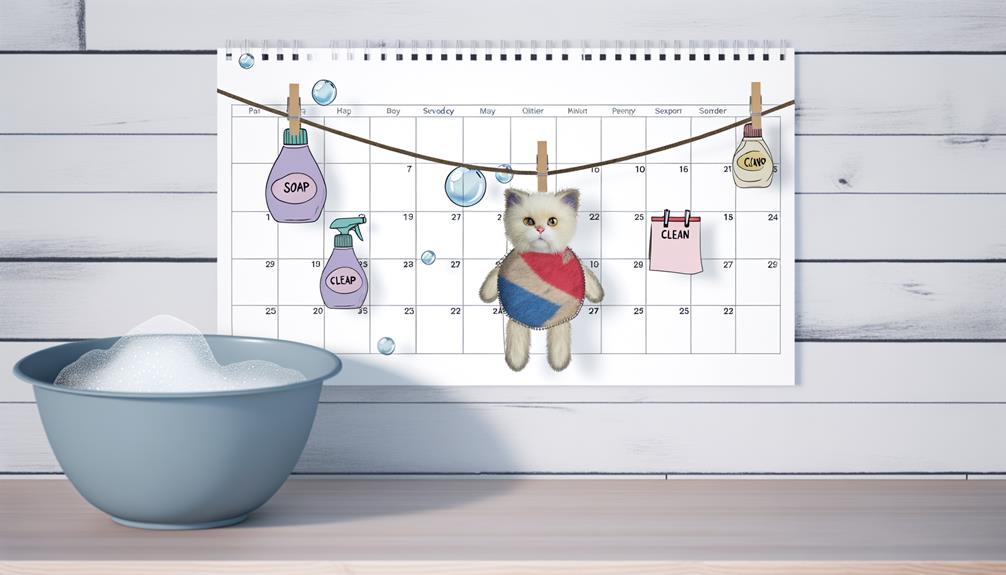
To maintain ideal hygiene, establish a weekly cleaning schedule for your cat's most frequently used toys, particularly those made of plastic or rubber. Immediate cleaning post-playtime, especially for outdoor toys, is essential to eliminate dirt and potential pathogens. Regular inspections and timely maintenance will minimize health risks, ensuring a safe play environment for your feline companion.
Weekly Cleaning Schedule
Maintaining a weekly cleaning schedule for your cat's toys is crucial for ideal hygiene and health. Cleaning on a regular basis helps prevent the buildup of bacteria, dirt, and other contaminants that can compromise your cat's well-being. For frequently used plastic toys, aim to clean them at least once a week. Use soapy water and verify they're thoroughly rinsed to remove any residual cleaning agents.
Soft fabric toys also require weekly washing. These can harbor more bacteria, especially if your cat takes them outdoors. If the toys become visibly dirty before the week is up, don't hesitate to clean them more frequently. A mild detergent in the washing machine, followed by air drying, is usually effective.
Interactive or feeding toys that come into direct contact with food and saliva should be cleaned after each use. This minimizes the risk of contamination and keeps feeding sessions safe for your cat.
In addition, establish a monthly deep cleaning routine for all toys. This thorough approach not only enhances cleanliness but also prolongs the toys' lifespan. Don't forget to inspect toys for wear and tear during each cleaning session, replacing any damaged items promptly.
Post-Playtime Maintenance
After establishing a weekly cleaning schedule, it's equally important to implement post-playtime maintenance for your cat's toys. This guarantees that clean cat toys remain hygienic and free from pathogens that can affect your cat's health. For plastic toys, a quick rinse under hot water after each play session can prevent bacterial buildup. Fabric toys, which accumulate dirt and saliva more readily, should be checked and spot-cleaned if visibly dirty. Interactive or feeding toys require immediate washing after use to eliminate food residues and saliva, reducing contamination risks.
Here's a concise guide to help you manage post-playtime maintenance:
| Toy Type | Maintenance Action |
|---|---|
| Plastic Toys | Rinse with hot water |
| Fabric Toys | Spot-clean if visibly dirty |
| Interactive Toys | Wash immediately post-use |
| Feeding Toys | Immediate thorough cleaning |
| Outdoor Toys | Clean after each outdoor use |
Methods by Toy Type
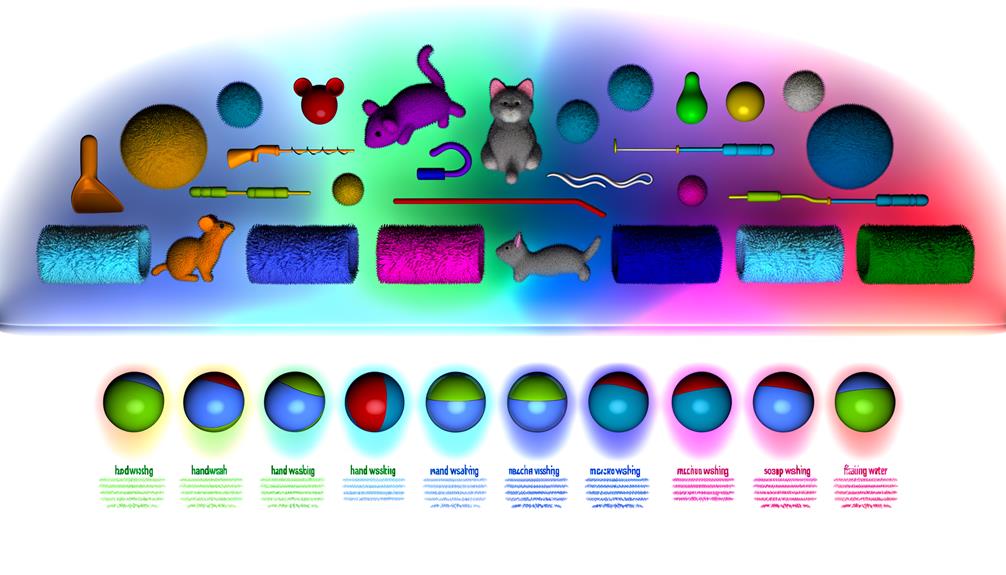
When it comes to maintaining your cat's toys, understanding the cleaning methods specific to each toy type is crucial for guaranteeing both hygiene and longevity. For fabric toys, always check the care label first. If they're machine washable, use a gentle cycle with mild detergent. For those that aren't, hand wash them in hot, soapy water, allowing them to soak for at least 30 minutes before a thorough rinse. Always air dry fabric toys to prevent any structural damage.
Catnip toys require a different approach. Avoid using detergents as they may leave harmful residues. Instead, soak these toys in a solution of equal parts vinegar and water. This method effectively cleans without introducing any potentially harmful substances. If the toys become heavily soiled or damaged, it's best to replace them to maintain your cat's safety and interest.
For plastic toys, hand washing is imperative since most aren't dishwasher safe. Use hot, soapy water and a sponge to scrub them clean. Guarantee thorough rinsing to remove all soap residue, as ingestion can harm your feline friend. Cleaning these toys weekly helps in maintaining peak hygiene and preventing bacterial buildup.
Sterilization Techniques
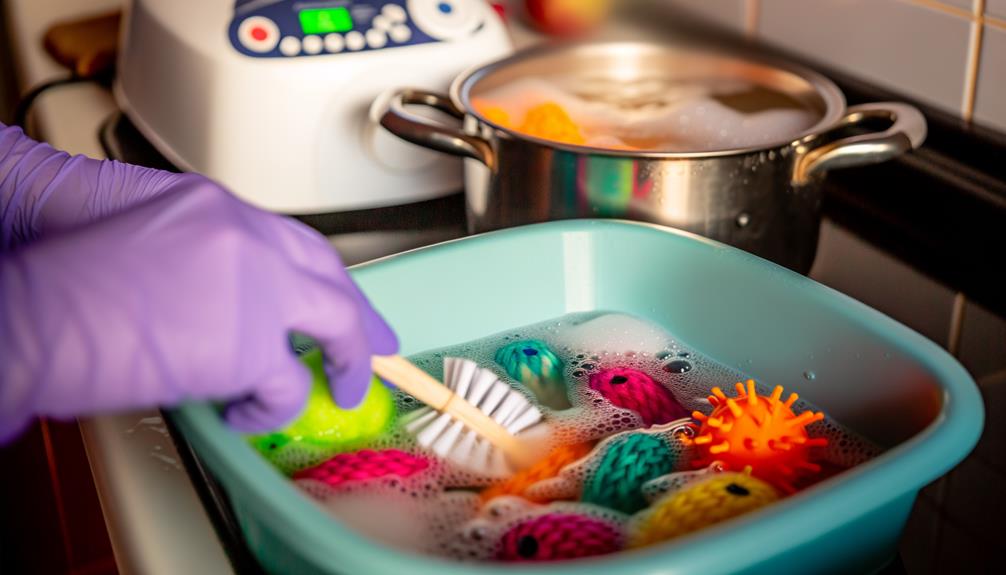
While understanding the cleaning methods specific to each toy type is important, implementing proper sterilization techniques guarantees an additional layer of protection against pathogens. Regularly sterilizing your cat's toys not only prevents odors but also mitigates the buildup of parasites, ensuring a healthier play environment.
For quick sterilization, pet-friendly disinfectant sprays or wipes are highly effective. These products are formulated to kill bacteria and viruses without leaving harmful residues that could be hazardous to your feline friend. Be sure to choose sprays explicitly labeled as pet-safe to avoid any adverse reactions.
Microwave-safe toys offer another efficient sterilization option. Simply wipe the toy down with a damp cloth and microwave it on high for one minute. This method effectively eliminates germs through the application of heat. However, always confirm that the toy material is microwave-safe to prevent any damage or safety risks.
Durable toys, such as those made of sturdy rubber or plastic, can be disinfected by running them through a hot water cycle in the washing machine. Importantly, omit detergent during this process as it might leave residues that are harmful to pets. The hot water alone is sufficient to sterilize the toys, preserving their structural integrity while eliminating pathogenic contaminants.
Before employing any sterilization techniques, it's essential to verify that the toy is compatible with the chosen method. Not all materials withstand high temperatures or disinfectant chemicals, and using the wrong technique could render the toy unsafe for your pet. By integrating these advanced sterilization techniques into your routine, you can greatly reduce the risk of infections, providing a safer and healthier playtime for your cat.
Signs for Replacement
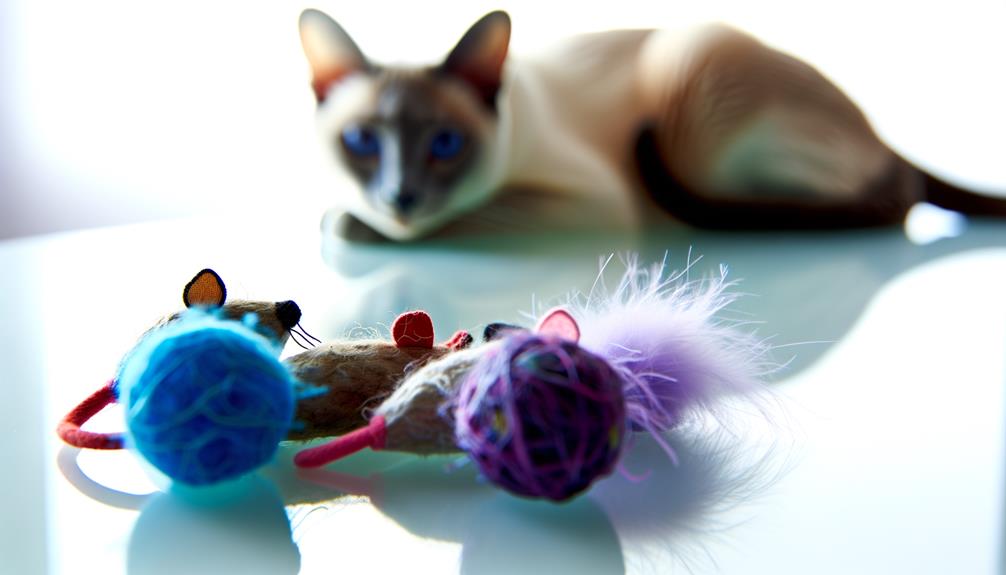
Recognizing the signs for replacing cat toys is important for maintaining your feline's safety and health. Frequent use can lead to toys becoming unrecognizable due to excessive wear. This degradation often poses safety risks to your cat, making it essential to inspect toys regularly.
When you inspect a toy, look for sharp edges or flaking plastic. These can cause injuries or become choking hazards. If you notice torn seams or loose details, it's important to replace the toy immediately. Loose components, especially small parts, can detach and pose considerable choking risks.
Another red flag is if catnip or stuffing is leaking from the toy. Such leakage indicates that the toy's structural integrity is compromised. The ingestion of these materials can be harmful to your cat's gastrointestinal tract, necessitating immediate replacement.
Regular assessment of the toy's condition is crucial. If cleaning does not greatly improve its appearance or safety, it's best to dispose of it. This step guarantees that your cat isn't exposed to potential hazards that could compromise their well-being.
Additionally, wear and tear can lead to microbial contamination, making toys unsanitary despite thorough cleaning. Thus, even if a toy appears superficially clean, its internal structure might harbor bacteria or fungi, which can be detrimental to your cat's health.
Maintaining a vigilant eye on the condition of your cat's toys and knowing when to replace them is an important aspect of pet ownership. Confirming that toys are in ideal condition not only fosters safe play but also promotes a healthy and hazard-free environment for your feline friend.
Best Practices

Maintaining your cat's toys in optimal condition requires adherence to specific cleaning protocols. For cleaning your cat's toys effectively, whether they are fabric toys or plastic toys, it's important to follow a precise regimen to guarantee their safety and longevity.
For fabric toys, using a mild detergent or a vinegar solution is preferred. Soak the fabric toys for 20-30 minutes, which allows the solution to penetrate and dislodge contaminants. After soaking, rinse the toys thoroughly to remove any residual cleaning agents, as these chemicals could pose a risk to your cat's health.
When it comes to plastic toys, hand washing in hot, soapy water is recommended. Use a sponge to clean the toys, as abrasive materials can cause scratches where bacteria might thrive. Cleaning these toys at least once a week is critical to minimizing bacterial buildup, which can be harmful to your cat.
Regular inspection of all toys is important. Check for any signs of wear and tear, such as sharp edges, leaking stuffing, or excessive soiling. Dispose of any toys that are damaged beyond repair to prevent potential injury or ingestion of hazardous materials.
Interactive and feeding toys require immediate attention after each use. These toys can harbor food residues, leading to bacterial contamination. Thorough cleaning after each use guarantees they remain safe for your cat.
Lastly, make sure all toys are completely dry before returning them to your cat. Moisture can lead to mold growth, presenting further health risks. By adhering to these best practices, you can maintain a safe and hygienic environment for your feline companion.
